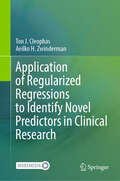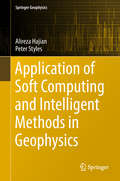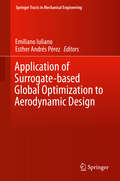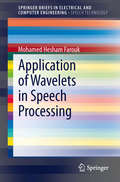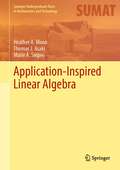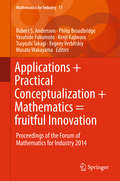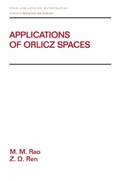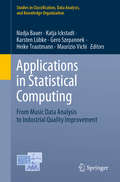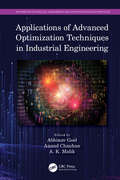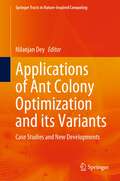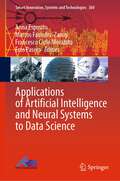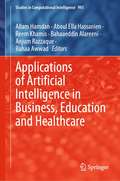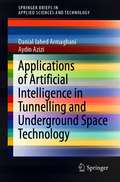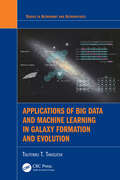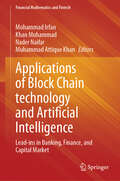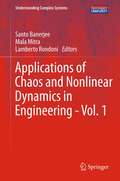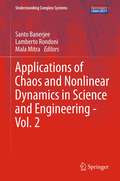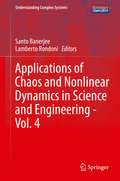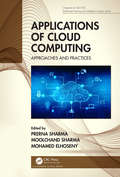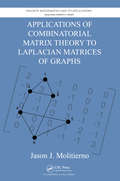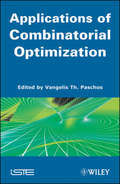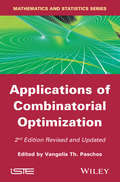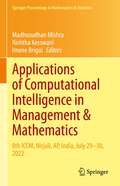- Table View
- List View
Application of Regularized Regressions to Identify Novel Predictors in Clinical Research
by Aeilko H. Zwinderman Ton J. CleophasThis textbook is an important novel menu for multiple variables regression entitled "regularized regression". It is a must have for identifying unidentified leading factors. Also, you get fitted parameters for your overfitted data. Finally, there is no more need for commonly misunderstood p-values. Instead, the regression coefficient, R-value, as reported from a regression line has been applied as the key predictive estimator of the regression study. With simple one by one variable regression it is no wider than -1 to +1. With multiple variables regression it can easily get > +1 or In the past two decades regularized regression has become a major topic of research, particularly with high dimensional data. Yet, the method is pretty new and infrequently used in real-data analysis. Its performance as compared to traditional null hypothesis testing has to be confirmed by prospective comparisons. Most studies published to date are of a theoretical nature involving statistical modeling and simulation studies. The journals Nature and Science published 19 and 10 papers of this sort in the past 8 years. The current edition will for the first time systematically test regularized regression against traditional regression analysis in 20 clinical data examples. The edition is also a textbook and tutorial for medical and healthcare students as well as recollection bench and help desk for professionals. Each chapter can be studied as a standalone, and, using, real as well as hypothesized data, it tests the performance of the novel methodology against traditional regressions. Step by step analyses of 20 data files are included for self-assessment. The authors are well qualified in their field. Professor Zwinderman is past-president of the International Society of Biostatistics and Professor Cleophas is past-president of the American College of Angiology. The authors have been working together for 25 years and their research can be characterized as a continued effort to demonstrate that clinical data analysis is a discipline at the interface of biology and mathematics.
Application of Soft Computing and Intelligent Methods in Geophysics (Springer Geophysics)
by Alireza Hajian Peter StylesThis book provides a practical guide to applying soft-computing methods to interpret geophysical data. It discusses the design of neural networks with Matlab for geophysical data, as well as fuzzy logic and neuro-fuzzy concepts and their applications. In addition, it describes genetic algorithms for the automatic and/or intelligent processing and interpretation of geophysical data.
Application of Surrogate-based Global Optimization to Aerodynamic Design (Springer Tracts in Mechanical Engineering)
by Emiliano Iuliano Esther Andrés PérezAerodynamic design, like many other engineering applications, is increasingly relying on computational power. The growing need for multi-disciplinarity and high fidelity in design optimization for industrial applications requires a huge number of repeated simulations in order to find an optimal design candidate. The main drawback is that each simulation can be computationally expensive - this becomes an even bigger issue when used within parametric studies, automated search or optimization loops, which typically may require thousands of analysis evaluations. The core issue of a design-optimization problem is the search process involved. However, when facing complex problems, the high-dimensionality of the design space and the high-multi-modality of the target functions cannot be tackled with standard techniques. In recent years, global optimization using meta-models has been widely applied to design exploration in order to rapidly investigate the design space and find sub-optimal solutions. Indeed, surrogate and reduced-order models can provide a valuable alternative at a much lower computational cost. In this context, this volume offers advanced surrogate modeling applications and optimization techniques featuring reasonable computational resources. It also discusses basic theory concepts and their application to aerodynamic design cases. It is aimed at researchers and engineers who deal with complex aerodynamic design problems on a daily basis and employ expensive simulations to solve them.
Application of Wavelets in Speech Processing (SpringerBriefs in Speech Technology)
by Mohamed Hesham FaroukThis book provides a survey on wide-spread of employing wavelets analysis in different applications of speech processing. The author examines development and research in different applications of speech processing. The book also summarizes the state of the art research on wavelet in speech processing.
Application of Wavelets in Speech Processing (SpringerBriefs in Speech Technology)
by Mohamed Hesham FaroukThis book provides a survey on wide-spread of employing wavelets analysis in different applications of speech processing. The author examines development and research in different applications of speech processing. The book also summarizes the state of the art research on wavelet in speech processing.
Application-Inspired Linear Algebra (Springer Undergraduate Texts in Mathematics and Technology)
by Heather A. Moon Thomas J. Asaki Marie A. SnipesThis textbook invites students to discover abstract ideas in linear algebra within the context of applications. Diffusion welding and radiography, the two central applications, are introduced early on and used throughout to frame the practical uses of important linear algebra concepts. Students will learn these methods through explorations, which involve making conjectures and answering open-ended questions. By approaching the subject in this way, new avenues for learning the material emerge: For example, vector spaces are introduced early as the appropriate setting for the applied problems covered; and an alternative, determinant-free method for computing eigenvalues is also illustrated. In addition to the two main applications, the authors also describe possible pathways to other applications, which fall into three main areas: Data and image analysis (including machine learning); dynamical modeling; and optimization and optimal design. Several appendices are included as well, one of which offers an insightful walkthrough of proof techniques. Instructors will also find an outline for how to use the book in a course. Additional resources can be accessed on the authors’ website, including code, data sets, and other helpful material. Application-Inspired Linear Algebra will motivate and immerse undergraduate students taking a first course in linear algebra, and will provide instructors with an indispensable, application-first approach.
Applications + Practical Conceptualization + Mathematics = fruitful Innovation: Proceedings of the Forum of Mathematics for Industry 2014 (Mathematics for Industry #11)
by Philip Broadbridge Yasuhide Fukumoto Tsuyoshi Takagi Robert S. Anderssen Kenji Kajiwara Evgeny Verbitskiy Masato WakayamaThis book is a collection of papers presented at the conference "Forum Math-for-Industry 2014" for which the unifying theme was "Applications + Practical Conceptualization + Mathematics = fruitful Innovation" in October 2014. This epigram encapsulates the dynamics of the process that takes an application through to an innovation. Industrial mathematics can be viewed as the causal engine that implements the epigram by taking an Application such as input and convolving it with a mixture of Practical Conceptualization and Mathematics to generate a fruitful Innovation as output. The book illustrates various aspects of the two-way interaction between applications and their association highlighting how practical conceptualization assists with the linking of the question that encapsulates the current application to the relevant mathematics. The contents of this volume address productive and successful interaction between industry and mathematicians, as well as the cross-fertilization and collaboration that result when mathematics is involved with the advancement of science and technology.
Applications Of Orlicz Spaces
by M.M. Rao Z.D. RenPresents previously unpublished material on the fundumental pronciples and properties of Orlicz sequence and function spaces. Examines the sample path behavior of stochastic processes. Provides practical applications in statistics and probability.
Applications in Reliability and Statistical Computing (Springer Series in Reliability Engineering)
by Hoang PhamThis book discusses practical applications of reliability and statistical methods and techniques in various disciplines, using machine learning, artificial intelligence, optimization, and other computation methods. Bringing together research from international experts, each chapter aims to cover both methods and practical aspects on reliability or statistical computations with emphasis on applications. 5G and IoT are set to generate an estimated 1 billion terabytes of data by 2025 and companies continue to search for new techniques and tools that can help them practice data collection effectively in promoting their business. This book explores the era of big data through reliability and statistical computing, showcasing how almost all applications in our daily life have experienced a dramatic shift in the past two decades to a truly global industry. Including numerous illustrations and worked examples, the book is of interest to researchers, practicing engineers, and postgraduate students in the fields of reliability engineering, statistical computing, and machine learning.
Applications in Statistical Computing: From Music Data Analysis to Industrial Quality Improvement (Studies in Classification, Data Analysis, and Knowledge Organization)
by Maurizio Vichi Heike Trautmann Karsten Lübke Nadja Bauer Katja Ickstadt Gero SzepannekThis volume presents a selection of research papers on various topics at the interface of statistics and computer science. Emphasis is put on the practical applications of statistical methods in various disciplines, using machine learning and other computational methods. The book covers fields of research including the design of experiments, computational statistics, music data analysis, statistical process control, biometrics, industrial engineering, and econometrics. Gathering innovative, high-quality and scientifically relevant contributions, the volume was published in honor of Claus Weihs, Professor of Computational Statistics at TU Dortmund University, on the occasion of his 66th birthday.
Applications of Advanced Optimization Techniques in Industrial Engineering (Information Technology, Management and Operations Research Practices)
by Abhinav Goel Anand Chauhan A. K. MalikThis book provides different approaches used to analyze, draw attention, and provide an understanding of the advancements in the optimization field across the globe. It brings all of the latest methodologies, tools, and techniques related to optimization and industrial engineering into a single volume to build insights towards the latest advancements in various domains. Applications of Advanced Optimization Techniques in Industrial Engineering includes the basic concept of optimization, techniques, and applications related to industrial engineering. Concepts are introduced in a sequential way along with explanations, illustrations, and solved examples. The book goes on to explore applications of operations research and covers empirical properties of a variety of engineering disciplines. It presents network scheduling, production planning, industrial and manufacturing system issues, and their implications in the real world. The book caters to academicians, researchers, professionals in inventory analytics, business analytics, investment managers, finance firms, storage-related managers, and engineers working in engineering industries and data management fields.
Applications of Ant Colony Optimization and its Variants: Case Studies and New Developments (Springer Tracts in Nature-Inspired Computing)
by Nilanjan DeyThis book explains the basic ideas behind several variants of ant colony optimization (ACO) and shows how they may be used in real-world settings like manufacturing, engineering design, and health care. Marco Dorigo proposed ACO for the first time, and it has been used to solve a variety of optimization problems. This book presents the latest developments of ACO.
Applications of Artificial Intelligence and Neural Systems to Data Science (Smart Innovation, Systems and Technologies #360)
by Anna Esposito Marcos Faundez-Zanuy Francesco Carlo Morabito Eros PaseroThis book provides an overview on the current progresses in artificial intelligence and neural nets in data science. The book is reporting on intelligent algorithms and applications modeling, prediction, and recognition tasks and many other application areas supporting complex multimodal systems to enhance and improve human–machine or human–human interactions. This field is broadly addressed by the scientific communities and has a strong commercial impact since investigates on the theoretical frameworks supporting the implementation of sophisticated computational intelligence tools. Such tools will support multidisciplinary aspects of data mining and data processing characterizing appropriate system reactions to human-machine interactional exchanges in interactive scenarios. The emotional issue has recently gained increasing attention for such complex systems due to its relevance in helping in the most common human tasks (like cognitive processes, perception, learning, communication, and even "rational" decision-making) and therefore improving the quality of life of the end users.
Applications of Artificial Intelligence in Business, Education and Healthcare (Studies in Computational Intelligence #954)
by Aboul Ella Hassanien Allam Hamdan Anjum Razzaque Bahaaeddin Alareeni Reem Khamis Bahaa AwwadThis book focuses on the implementation of Artificial Intelligence in Business, Education and Healthcare, It includes research articles and expository papers on the applications of Artificial Intelligence on Decision Making, Entrepreneurship, Social Media, Healthcare, Education, Public Sector, FinTech, and RegTech. It also discusses the role of Artificial Intelligence in the current COVID-19 pandemic, in the health sector, education, and others. It also discusses the impact of Artificial Intelligence on decision-making in vital sectors of the economy.
Applications of Artificial Intelligence in Tunnelling and Underground Space Technology (SpringerBriefs in Applied Sciences and Technology)
by Aydin Azizi Danial Jahed ArmaghaniThis book covers the tunnel boring machine (TBM) performance classifications, empirical models, statistical and intelligent-based techniques which have been applied and introduced by the researchers in this field. In addition, a critical review of the available TBM performance predictive models will be discussed in details. Then, this book introduces several predictive models i.e., statistical and intelligent techniques which are applicable, powerful and easy to implement, in estimating TBM performance parameters. The introduced models are accurate enough and they can be used for prediction of TBM performance in practice before designing TBMs.
Applications of Big Data and Machine Learning in Galaxy Formation and Evolution (Series in Astronomy and Astrophysics)
by Tsutomu T. TakeuchiAs investigations into our Universe become more complex, in-depth, and widespread, galaxy surveys are requiring state-of-the-art data scientific methods to analyze them. This book provides a practical introduction to big data in galaxy formation and evolution, introducing the astrophysical basics, before delving into the latest techniques being introduced to astronomy and astrophysics from data science. This book helps translate the cutting-edge methods into accessible guidance for those without a formal background in computer science. It is an ideal manual for astronomers and astrophysicists, in addition to graduate students and postgraduate students in science and engineering looking to learn how to apply data-science to their research.Key Features: Introduces applications of data-science methods to the exciting subject of galaxy formation and evolution Provides a practical guide to understanding cutting-edge data-scientific methods, as well as classical astrostatistical methods Summarises a vast range of statistical and informatics methods in one volume, with concrete applications to astrophysics
Applications of Block Chain technology and Artificial Intelligence: Lead-ins in Banking, Finance, and Capital Market (Financial Mathematics and Fintech)
by Mohammad Irfan Khan Muhammad Muhammad Attique Khan Nader NaifarToday, emerging technologies offer a new pathway for advancing the economy in the fields of banking, finance, and capital markets. Blockchain applications play a crucial role in ensuring trust and security within these industries by relying on transparency and visibility through peer-to-peer networks. The banking industry has also witnessed increased operations speed, better transparency, efficiency enhancement, fraud extenuation at less cost while sharing real-time data between various parties. Thus, the adoption of blockchain in the Banking and Insurance industry is developing very fast. It has emerged as the commonly accepted default platform for the banking and insurance industry. This book explores how blockchain technology optimizes and integrates transactions and operations, facilitating easier access to information. This, in turn, has the potential to reduce communication costs and minimize minor data transfer errors. Additionally, the book delves into the current applications of blockchain technology in the financial industry, discusses its limitations, and outlines its future prospects for broader accessibility. This book is aimed at students and researchers in financial engineering and fintech and it can serve as a reference for identifying problem areas and their possible solutions.
Applications of Chaos and Nonlinear Dynamics in Engineering - Vol. 1 (Understanding Complex Systems)
by Lamberto Rondoni Santo Banerjee Mala MitraChaos and nonlinear dynamics initially developed as a new emergent field with its foundation in physics and applied mathematics. The highly generic, interdisciplinary quality of the insights gained in the last few decades has spawned myriad applications in almost all branches of science and technology--and even well beyond. Wherever quantitative modeling and analysis of complex, nonlinear phenomena is required, chaos theory and its methods can play a key role. This volume concentrates on reviewing the most relevant contemporary applications of chaotic nonlinear systems as they apply to the various cutting-edge branches of engineering. The book covers the theory as applied to robotics, electronic and communication engineering (for example chaos synchronization and cryptography) as well as to civil and mechanical engineering, where its use in damage monitoring and control is explored). Featuring contributions from active and leading research groups, this collection is ideal both as a reference and as a 'recipe book' full of tried and tested, successful engineering applications
Applications of Chaos and Nonlinear Dynamics in Science and Engineering - Vol. 2 (Understanding Complex Systems)
by Lamberto Rondoni Santo Banerjee Mala MitraChaos and nonlinear dynamics initially developed as a new emergent field with its foundation in physics and applied mathematics. The highly generic, interdisciplinary quality of the insights gained in the last few decades has spawned myriad applications in almost all branches of science and technology--and even well beyond. Wherever the quantitative modeling and analysis of complex, nonlinear phenomena are required, chaos theory and its methods can play a key role. This second volume concentrates on reviewing further relevant, contemporary applications of chaotic nonlinear systems as they apply to the various cutting-edge branches of engineering. This encompasses, but is not limited to, topics such as the spread of epidemics; electronic circuits; chaos control in mechanical devices; secure communication; and digital watermarking. Featuring contributions from active and leading research groups, this collection is ideal both as a reference work and as a 'recipe book' full of tried and tested, successful engineering applications.
Applications of Chaos and Nonlinear Dynamics in Science and Engineering - Vol. 3 (Understanding Complex Systems)
by Lamberto Rondoni Santo BanerjeeChaos and nonlinear dynamics initially developed as a new emergent field with its foundation in physics and applied mathematics. The highly generic, interdisciplinary quality of the insights gained in the last few decades has spawned myriad applications in almost all branches of science and technology--and even well beyond. Wherever quantitative modeling and analysis of complex, nonlinear phenomena is required, chaos theory and its methods can play a key role. This third volume concentrates on reviewing further relevant contemporary applications of chaotic nonlinear systems as they apply to the various cutting-edge branches of engineering. This encompasses, but is not limited to, topics such fluctuation relations and chaotic dynamics in physics, fractals and their applications in epileptic seizures, as well as chaos synchronization. Featuring contributions from active and leading research groups, this collection is ideal both as a reference and as a 'recipe book' full of tried and tested, successful engineering applications.
Applications of Cloud Computing: Approaches and Practices (Chapman & Hall/CRC Distributed Sensing and Intelligent Systems Series)
by Mohamed Elhoseny Prerna Sharma Moolchand SharmaIn the era of the Internet of Things and with the explosive worldwide growth of electronic data volume, and associated need of processing, analysis, and storage of such a humongous amount of data, it has now become mandatory to exploit the power of massively parallel architecture for fast computation. Cloud computing provides a cheap source of such a computing framework for a large volume of data for real-time applications. It is, therefore, not surprising to see that cloud computing has become a buzzword in the computing fraternity over the last decade. Applications of Cloud Computing: Approaches and Practices lays a good foundation for the core concepts and principles of cloud computing applications, walking the reader through the fundamental ideas with expert ease. The book progresses on the topics in a step-by-step manner. It reinforces theory with a full-fledged pedagogy designed to enhance students' understanding and offer them a practical insight into the applications of it. It is a valuable source of knowledge for researchers, engineers, practitioners, and graduate and doctoral students working in the field of cloud computing. It will also be useful for faculty members of graduate schools and universities.
Applications of Combinatorial Matrix Theory to Laplacian Matrices of Graphs (Discrete Mathematics and Its Applications)
by Jason J. MolitiernoOn the surface, matrix theory and graph theory seem like very different branches of mathematics. However, adjacency, Laplacian, and incidence matrices are commonly used to represent graphs, and many properties of matrices can give us useful information about the structure of graphs.Applications of Combinatorial Matrix Theory to Laplacian Matrices o
Applications of Combinatorial Optimization (Wiley-iste Ser.)
by Vangelis Th. PaschosCombinatorial optimization is a multidisciplinary scientific area, lying in the interface of three major scientific domains: mathematics, theoretical computer science and management. The three volumes of the Combinatorial Optimization series aims to cover a wide range of topics in this area. These topics also deal with fundamental notions and approaches as with several classical applications of combinatorial optimization. “Applications of Combinatorial Optimization” is presenting a certain number among the most common and well-known applications of Combinatorial Optimization.
Applications of Combinatorial Optimization (Wiley-iste Ser.)
by Vangelis Th. PaschosCombinatorial optimization is a multidisciplinary scientific area, lying in the interface of three major scientific domains: mathematics, theoretical computer science and management. The three volumes of the Combinatorial Optimization series aim to cover a wide range of topics in this area. These topics also deal with fundamental notions and approaches as with several classical applications of combinatorial optimization. Concepts of Combinatorial Optimization, is divided into three parts: - On the complexity of combinatorial optimization problems, presenting basics about worst-case and randomized complexity; - Classical solution methods, presenting the two most-known methods for solving hard combinatorial optimization problems, that are Branch-and-Bound and Dynamic Programming; - Elements from mathematical programming, presenting fundamentals from mathematical programming based methods that are in the heart of Operations Research since the origins of this field.
Applications of Computational Intelligence in Management & Mathematics: 8th ICCM, Nirjuli, AP, India, July 29–30, 2022 (Springer Proceedings in Mathematics & Statistics #417)
by Nishtha Kesswani Imene Brigui Madhusudhan MishraComputational intelligence consists of those techniques that imitate the human brain and nature to adopt the decision-making approach. This book contains selected papers from the 8th International Conference on Computers, Management and Mathematical Sciences (ICCM) 2022 about fuzzy systems, neural networks and evolutionary computation that can address stochastic environments where reasoning is a significant attribute to derive potential solutions and focus on the business domain's computational aspects.This is a conference proceedings for scholars/students who are using the powerful algorithms, concepts and principles of computational intelligence in a wide spectrum of research cases.
